There are two types of scales:
· Chromatic Scale
· Diatonic Scale
A chromatic scale uses all twelve notes between any note and its octave. That’s fancy talk for saying that it uses every note available, including all the sharps/flats, as the scale ascends. It looks like this:

…See how the chromatic scale is separated only by semitones? No tones are present in this scale. You can look at the chromatic scale as the “Mother” of all scales. It serves as foundation for other scales.
The diatonic scale is what we use to make music. All music can be traced to a scale of some sort. There are two kinds of diatonic scales:
- The Major Scale
- The minor Scale
A diatonic scale has five tones and two semitones. The order of these tones is what gives us the specific Major or minor scale. There are many, many different scales that you can make using various combinations of tones and semitones.
Here is a basic C Major scale:

What pattern of tones and semitones does the above scale have? Let’s see.

By taking a look at the distance between each note, we come up with the pattern:
Tone Tone Semitone Tone Tone Tone Semitone
Congratulations! You’ve just discovered the tone/semitone pattern for a Major scale! From that information, you can create any guitar major scale patterns you want. Here is how guitar scales explained in details.
C Major Scale is one of the easiest and simplest scales to understand because it doesn’t have any flats or sharps.
Here are some variations to play C Major Scale across the fretboard. Below are the guitar scales tabs for C Major Scale guitar positions …
C Major Scale with Open Positions…
E|--------------------------|---------------------------| B|--------------------0--1--|--0------------------------| G|--------------0--2--------|------2--0-----------------| D|-----0--2--3--------------|-------------3--2--0-------| A|--3-----------------------|-----------------------3---| E|--------------------------|---------------------------|
C Major Scale starting on the 6th string
E|---------------------------------------------7--8--| B|---------------------------------------8--10-------| G|-----------------------------7--9--10--------------| D|-------------------7--9--10------------------------| A|---------7--8--10----------------------------------| E|--8--10--------------------------------------------|
E|--8--7---------------------------------------------| B|--------10--8--------------------------------------| G|--------------10--9--7-----------------------------| D|------------------------10--9--7-------------------| A|----------------------------------10--8--7---------| E|--------------------------------------------10--8--|
C Major Scale starting on the 5th string
E|-----------------------------------------------| B|-----------------------------------------------| G|-----------------2--4--5--4--2-----------------| D|--------2--3--5-----------------5--3--2--------| A|--3--5-----------------------------------5--3--| E|-----------------------------------------------|
C Major Scale starting on the 4th string
E|------------------------------------------------------------| B|---------------------10--12--13--12--10---------------------| G|----------9--10--12----------------------12--10--9----------| D|--10--12--------------------------------------------12--10--| A|------------------------------------------------------------| E|------------------------------------------------------------|
C Major Scale starting on the 3rd string
E|-----------------5--7--8--7--5-----------------| B|--------5--6--8-----------------8--6--5--------| G|--5--7-----------------------------------7--5--| D|-----------------------------------------------| A|-----------------------------------------------| E|-----------------------------------------------|
Here is a beginner guitar scales video that will show you how to play guitar scales for beginners…
The pentatonic scale is one of the most used scales by guitarists. Knowing how it works can bring you to new heights with your playing.
The pentatonic scale comes from the Greek word “Pente,” which means five. In the pentatonic scale, there are only five notes. It is formed by taking out the fourth and seventh degree of any major scale.
This scale has an impressive history that dates back to 2000 B.C. and unlike all of the scales we have studied, it is not a part of European music. In fact, the pentatonic scale comes from oriental music.
The pentatonic scale patterns guitar has both a major and a minor, much like diatonic scales do.
The major pentatonic scale guitar is just like a diatonic major scale but with the 4th and 7th scale degrees removed. Here is an example of a G Major pentatonic scale tab for G Major Scale…
G Major Scale
E |----------------------------------------------2--3--| B |---------------------------------------3--5---------| G |----------------------------2--4--5-----------------| D |------------------2--4--5---------------------------| A |--------2--3--5-------------------------------------| E |-3--5-----------------------------------------------|
G Major Pentatonic Scale
E |------------------------------------3--| B |-----------------------------3--5------| G |----------------------2--4-------------| D |---------------2--5--------------------| A |--------2--5---------------------------| E |-3--5----------------------------------|
The minor pentatonic scale has the 2nd and 6th degrees removed. Its key signature is found by finding the relative major scale. Here is a minor pentatonic scale tab for E Minor Scale…
E minor scale
E |---------------------------------------------7--8--10--12--| B |--------------------------------7--8—10--------------------| G |-------------------------7--9------------------------------| D |-------------7--9--10--------------------------------------| A |-7--9--10--------------------------------------------------| E |-----------------------------------------------------------|
E minor pentatonic scale
E |--------------------------------7--10—12--| B |-----------------------8--10--------------| G |----------------7--9----------------------| D |---------7--9-----------------------------| A |-7--10------------------------------------| E |------------------------------------------|
Scales are important to build strength in your fingers and also helps to train you ears to recognize some common note combinations.
Learning guitar scales are an essential asset to any guitarist who wants to see a nonstop stream of success.
For bass guitar scales, here is a bass guitar scales chart for your reference…

There are dozens of different scales and modes, major scales, natural scales, melodic scales, harmonic minor scales, the major and minor pentatonic scale, dorian, lydian, mixolydian, aeolian or phrygian mode and even more.
If you search online, you might find blues guitar scales pdf to download. There are blues guitar scales tutorial for learning guitar scales for beginners.
For the blues scale guitar, Dominant 7 chords are the most common type of chord utilized in the Blues Style.
So, what exactly is a Dominant 7? It’s a major triad with a lowered 7th meaning the 7th is a whole step below the root.
Example: C E G Bb
“C-E-G” is the major triad and the “Bb” is the lowered 7th.

There are other chords you’ll find in the Blues that aren’t of the Dominant variety – in this case we’re talking about the minor 7 chord.
So, what exactly is a Minor 7? It’s a minor triad with a lowered 7th meaning the 7th is a whole step below the root.
Example: C Eb G Bb “C-Eb-G” is the minor triad and the “Bb” is the lowered 7th.

Another important chord that you need to know is a Major 7. It’s a major triad with a raised 7th meaning the 7th is a half step below the root.
Example: C E G B
“C-E-G” is the major triad and the “B” is the raised 7th.
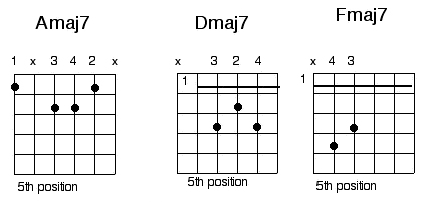
12-Bar Blues is important to learn in blues style guitar. It is the most popular form used in songwriting and jam sessions and the best part is that it only requires 3 chords.
These 3 chords are referred to as the “1-4-5”. This means you’ll be playing dominant 7 chords from the root, 4th note, and 5th note of the key you’re in.
For example, if you’re in “E” you’ll be playing: E7, A7, and B7
The 12 Bar Blues can be played in any key however; the most popular is in “E”.
12 Bar Blues in E
E7 A7 E7 A7 E7 B7 A7 E7 B7
E |-----------5--------------------5-----------------7----5------------7--| B |--5--------5---------5--—-------5---------5-------7----5------5-----7--| G |--7--------6---------7----------6---------7-------8----6------7-----8--| D |--6--------5---------6----------5---------6-------7----5------6-----7--| A |--7--------7---------7----------7---------7-------9----7------5-----9--| E |-----------5--------------------5-----------------7----5------------7-—|
(With blues guitar scales tabs)
Here is the guitar major scale chart patterns for guitar.

Major Scales: 6th String Forms
Every solo you hear regardless of style uses scales. Everything you can possible play begins with scales.
4th Finger Form
E |-------------------------------------------5--7—8--| B |---------------------------------5--6--8-----------| G |----------------------4--5--7----------------------| D |---------------5--7--------------------------------| A |-----5--7--8---------------------------------------| E |--8------------------------------------------------|
2nd Finger Form
E |------------------------------------------------7—8--| B |----------------------------------------8--10--------| G |-----------------------------7--9--10----------------| D |------------------7--9--10---------------------------| A |-------7--8--10--------------------------------------| E |-8-10------------------------------------------------|
1st Finger Form
E |------------------------------------------------------| B |--------------------------------------------10—12—13--| G |---------------------------------9—10—12--------------| D |---------------------9—10—12--------------------------| A |-----------8—10—12------------------------------------| E |-8—10—12----------------------------------------------|
Major Scales: 5th String Forms
4th Finger Form
E |--------------------------------------12-13-15-17-19-20-| B |--------------------------12--13--15--------------------| G |-------------------12--14-------------------------------| D |------12--14--15----------------------------------------| A |-15-----------------------------------------------------| E |--------------------------------------------------------|
2nd Finger Form
E |--------------------------------------------15-17-19-20-| B |---------------------------------15--17--18-------------| G |---------------------14--16--17-------------------------| D |---------14--15--17-------------------------------------| A |-15--17-------------------------------------------------| E |--------------------------------------------------------|
1st Finger Form
E |-----------------------------------------------17-19-20-| B |-----------------------------------17--18--20-----------| G |-----------------------16--17--19-----------------------| D |-----------15--17--19-----------------------------------| A |-15-17-19-----------------------------------------------| E |--------------------------------------------------------|
Learning guitar scale is very important once you learned the basic guitar chords.
The questions I get a lot with guitar scales are:
“How to read guitar scales?”
“What is the best way to memorize guitar scales?”
“What are the major scale guitar positions?”
There are lots of guitar major scales chart, major scales guitar pdf, major and minor pentatonic scale guitar pdf, guitar scales tabs pdf or guitar scales chart pdf to download. But which one do you follow as there are too many of them?
The most commonly used guitar scales are:
- Major Scales
- Natural Minor Scale
- Harmonic Minor Scale
- Melodic Minor Scale
- Major Pentatonic and Minor Pentatonic Scales
- Modes like Dorian, Mixolydian
Here are some guitar scales in tab form…
Guitar scales tabs – A Major Scale
E |-------------------------------------------4--5----| B |------------------------------------5--7-----------| G |---------------------------4--6--7-----------------| D |------------------4--6--7--------------------------| A |--------4--5--7------------------------------------| E |-5—-7----------------------------------------------|
Guitar scales tabs – A Minor Scale
E |---------------------------------------------5-----| B |------------------------------------5--6--8--------| G |---------------------------4--5--7-----------------| D |--------------------5--7---------------------------| A |----------5--7--8----------------------------------| E |-5—-7--8-------------------------------------------|
Guitar scales tabs – A Major Pentatonic Scale
E |------------------------------------5---| B |-----------------------------5--7-------| G |----------------------4--6--------------| D |---------------4--7---------------------| A |---------4--7---------------------------| E |--5--7----------------------------------|
Guitar scales tabs – A Minor Pentatonic Scale
E |------------------------------------5--| B |-----------------------------5--8------| G |----------------------5--7-------------| D |---------------5--7--------------------| A |---------5--7--------------------------| E |--5--8---------------------------------|
Guitar scales tabs – G Major Scale
E |----------------------------------------------2--3--| B |---------------------------------------3--5---------| G |----------------------------2--4--5-----------------| D |------------------2--4--5---------------------------| A |--------2--3--5-------------------------------------| E |-3--5-----------------------------------------------|
Guitar scales tabs – G Minor Scale
E |----------------------------------------------3-----| B |---------------------------------------3-4-6--------| G |-----------------------------2--3--5----------------| D |---------------------3--5---------------------------| A |-----------3—-5--6----------------------------------| E |-3—-5--6--------------------------------------------|
Guitar scales tabs – G Major Pentatonic Scale
E |------------------------------------3--| B |-----------------------------3--5------| G |----------------------2--4-------------| D |---------------2--5--------------------| A |--------2--5---------------------------| E |-3--5----------------------------------|
Guitar scales tabs – G Minor Pentatonic Scale
E |----------------------------------3--6-| B |----------------------------3--6-------| G |---------------------3--5--------------| D |---------------3--5--------------------| A |--------3--5---------------------------| E |-3--6----------------------------------|
Guitar scales tabs – C Major Scale
E|-----------------------------------------------7--8--| B|----------------------------------------8--10--------| G|------------------------------7--9--10---------------| D|-------------------7--9--10--------------------------| A|---------7--8--10------------------------------------| E|--8--10----------------------------------------------|
Guitar scales tabs – C Minor Scale
E|------------------------------------------------7--8-| B|-----------------------------------------8--9--------| G|-------------------------------7--8--10--------------| D|-----------------------9--10-------------------------| A|------------8--10--11--------------------------------| E|--8--10-11-------------------------------------------|
Guitar scales tabs – C Major Pentatonic Scale
E|-------------------------------------------8—---| B|----------------------------------8--10---------| G|---------------------------7--9-----------------| D|------------------7--10-------------------------| A|----------7--10---------------------------------| E|--8--10-----------------------------------------|
Guitar scales tabs – C Minor Pentatonic Scale
E|------------------------------------------8—11--| B|----------------------------------8--11---------| G|--------------------------8--10-----------------| D|------------------8--10-------------------------| A|----------8--10---------------------------------| E|--8--10-----------------------------------------|
Guitar scales tabs – E Major Scale
E |---------------------------------------7--9----| B |-----------------------------7—9-—10-----------| G |-------------------6--8--9---------------------| D |---------6--7--9-------------------------------| A |--7--9-----------------------------------------| E |-----------------------------------------------|
Guitar scales tabs – E Minor Scale
E |----------------------------------------7--8--10--12-| B |------------------------------7--8—10----------------| G |-----------------------7--9--------------------------| D |------------7--9--10---------------------------------| A |-7--9--10--------------------------------------------| E |-----------------------------------------------------|
Guitar scales tabs – E Major Pentatonic Scale
E |--------------------------------7--9----| B |-------------------------7--9-----------| G |-----------------6--9-------------------| D |---------6--9---------------------------| A |-7--9-----------------------------------| E |----------------------------------------|
Guitar scales tabs – E Minor Pentatonic Scale
E |-------------------------------7--10—12-| B |-----------------------8--10------------| G |----------------7--9--------------------| D |---------7--9---------------------------| A |-7--10----------------------------------| E |----------------------------------------|
Guitar scales tabs – D Major Scale
E |-----------------------------------5--7-| B |--------------------------5--7--8-------| G |-----------------4—-6--7----------------| D |--------4—-5--7-------------------------| A |--5--7----------------------------------| E |----------------------------------------|
Guitar scales tabs – D Minor Scale
E |-----------------------------5--8-------| B |----------------------6--8--------------| G |---------------5--7---------------------| D |---------5--7---------------------------| A |--5—8-----------------------------------| E |----------------------------------------|
Guitar scales tabs – D Major Pentatonic Scale
E |---------------------------5--7--10---| B |--------------------5--7--------------| G |--------------4--7--------------------| D |--------4--7--------------------------| A |--5--7--------------------------------| E |--------------------------------------|
Guitar scales tabs – D Minor Pentatonic Scale
E |----------------------------5--8--10--| B |--------------------6—-8--------------| G |--------------5--7--------------------| D |--------5--7--------------------------| A |--5--8--------------------------------| E |--------------------------------------|
It’s hard to find guitar scales tab pdf online. But use the above guitar scales tab for your reference.
G major or the key of G is a major scale based on G, which gives us the 7 notes G, A, B, C, D, E, and F♯. Its key signature has one sharp which is F♯.
G Major Scale can be played in many different ways and places on the guitar. Here is a guitar scale exercises pdf for you to work on on G Major Scale…
G Major Scale starting on the 6th string (Low E)
E|----------------------------------------------2--3--| B|---------------------------------------3--5---------| G|----------------------------2--4--5-----------------| D|------------------2--4--5---------------------------| A|--------2--3--5-------------------------------------| E|-3--5-----------------------------------------------|
G Major Scale starting on the 5th string (A)
E|----------------------------------------------------------| B|----------------------------------------------------------| G|---------------------9--11--12--11--9---------------------| D|----------9--10--12--------------------12--10--9----------| A|--10--12------------------------------------------12--10--| E|----------------------------------------------------------|
G Major Scale starting on the 4th string (D)
E|-----------------------------------------------| B|-----------------5--7--8--7--5-----------------| G|--------4--5--7-----------------7--5--4--------| D|--5--7-----------------------------------7--5--| A|-----------------------------------------------| E|-----------------------------------------------|
G Major Scale starting on the 3rd string (G)
E|-----------------0--2--3--2--0-----------------| B|--------0--1--3-----------------3--1--0--------| G|--0--2-----------------------------------2--0--| D|-----------------------------------------------| A|-----------------------------------------------| E|-----------------------------------------------|
Here are 4 important minor scale patterns to learn. They all cover 2 octaves except the 5th string, 4th finger form. I keep these scale patterns in a “Zone” or position as much as possible on the fingerboard to make them easier to play so you can learn how to practice guitar scales effectively
So, how do you form a minor scale?
Lower the 3rd, 6th & 7th scale degree of any major scale to create a minor scale.
Example –
C Major: C D E F G A B
C minor: C D Eb F G Ab Bb
Again, these scales are all transposable so you can play them anywhere on the
fingerboard. The scale name is derived from the starting note.
A minor scale: Position 1
E |------------------------------------5--| B |----------------------------5-6-8------| G |--------------------4-5-7--------------| D |---------------5-7---------------------| A |--------5-7-8--------------------------| E |-5-7-8---------------------------------|
A minor scale: Position 2
E |----------------------------------3-5--| B |--------------------------3-5-6--------| G |------------------2-4-5----------------| D |----------2-3-5------------------------| A |---2-3-5-------------------------------| E |-5-------------------------------------|
F# minor scale: Position 1
E |---------------------------7-9--| B |------------------7-9-10--------| G |----------6-7-9-----------------| D |---6-7-9------------------------| A |-9------------------------------| E |--------------------------------|
F# minor scale: Position 1
E |---------------------------------------9-10-12-14--| B |-----------------------------9-10-12---------------| G |----------------------9-11-------------------------| D |-----------9-11-12---------------------------------| A |-9-11-12-------------------------------------------| E |---------------------------------------------------|
I wish someone teach me guitar scales this way when I first started guitar scales tutorial. It is so much easier to understand.

How to use this all guitar scales chart? The red dots with the big M denotes the starting point for playing in the Major scale. So if the M red dot is on A note, you will be playing A Major.
Here is the basic guitar scales pdf video lesson…
Pentatonic scales are every guitarist’s best friend when they begin to solo and improvise. There is good reason for this – the scale is executed in a “Boxy” shape allowing the player to use only 2 notes per string. It’s also very easy to solo with because every note works well.
A pentatonic scale is a 5-note scale. The major pentatonic scale follows the tone pattern of Tone Tone Tone+Semitone Tone Tone+Semitone
Whereas the minor pentatonic scale follows the tone pattern of Tone+Semitone Tone Tone Tone+Semitone Tone
The major pentatonic scale guitar is just like a diatonic major scale but with the 4th and 7th scale degrees removed. Let’s have a look to the scale below…
G Major Scale
E |----------------------------------------------2--3--| B |---------------------------------------3--5---------| G |----------------------------2--4--5-----------------| D |------------------2--4--5---------------------------| A |--------2--3--5-------------------------------------| E |-3--5-----------------------------------------------|
G Major Pentatonic Scale
E |------------------------------------3--| B |-----------------------------3--5------| G |----------------------2--4-------------| D |---------------2--5--------------------| A |--------2--5---------------------------| E |-3--5----------------------------------|
Guitar scales fretboard can be used to refer to the notes on your guitar. If you have a good memory and able to memorise the notes on your guitar fretboard, that’s awesome. In the meantime, if you can’t, use the following diagram as a reference.

And here is an A major Scale Guitar Tab.
E |-------------------------------------------4--5----| B |------------------------------------5--7-----------| G |---------------------------4--6--7-----------------| D |------------------4--6--7--------------------------| A |--------4--5--7------------------------------------| E |-5—-7----------------------------------------------|
A major scale guitar notes A is made up of the notes A, B, C#, D, E, F#, and G#.
In music, the Phrygian dominant scale or altered Phrygian scale is the fifth mode of the harmonic minor scale where the fifth being the dominant. It looks like the scale of the Phrygian mode but has a major third.
The sequence of steps forming the Phrygian dominant scale is:
half – augmented second – half – whole – half – whole – whole
Beginning on C, the scale is:
C – D♭ – E – F – G – A♭ – B♭ – C
Check out the video below for phrygian dominant scale lesson…
The C Major Scale has the notes –
C D E F G A B C
For C major pentatonic scale, you get rid of the 4th and 7th so it becomes…
C D E G A B C
Let’s have a look at C Major Scale in tab format…
Guitar scales tabs – C Major Scale
E|-----------------------------------------------7--8--| B|----------------------------------------8--10--------| G|------------------------------7--9--10---------------| D|-------------------7--9--10--------------------------| A|---------7--8--10------------------------------------| E|--8--10----------------------------------------------|
As you can see on the C Major Pentatonic Scale below, the number is red were removed to become the C Major Pentatonic Scale.
Guitar scales tabs – C Major Pentatonic Scale
E|-------------------------------------------8—---| B|----------------------------------8--10---------| G|---------------------------7--9-----------------| D|------------------7--10-------------------------| A|----------7--10---------------------------------| E|--8--10-----------------------------------------|
For minor pentatonic scale formula, all you have to do is to remove the 2nd and 6th degrees and find the minor pentatonic scale notes.
There are a handful of blue scales that you need to learn if you want to play Blues guitar. The scales are:
- Dominant 7 chords
- Minor 7 Chords
- Major 7 Chords
- 12 Bar Blues
- The Minor Blues
- Dominant 7 Arpeggios
- Minor & Major Pentatonic Scales
- The Mixolydian Scale
These scales are what you need to complete your jump start into the Blues.
Let’s learn the first guitar scale for beginners – G Major Scale.
Before you start to play the scale, first I will show you how the scale diagram below with guitar tabs so you get the idea of how to read the scale…
G Major Guitar scales chart for beginners
G Major Guitar scales tabs for beginners
E |----------------------------------------------2--3--| B |---------------------------------------3--5---------| G |----------------------------2--4--5-----------------| D |------------------2--4--5---------------------------| A |--------2--3--5-------------------------------------| E |-3--5-----------------------------------------------|
Check out the video below to learn the major scales of guitar…
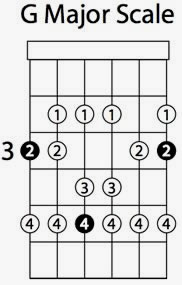
The guitar has a long history in jazz music as both an ensemble and solo instrument.
While jazz can be played on any type of guitar, from an acoustic to a solid-bodied electric guitar such as a Fender Stratocaster, the archtop guitar has become known as the prototypical “jazz guitar.”
What I love about jazz is when jazz guitar players improvise, they use the scales, modes and arpeggios associated with the chords in a tune’s chord progression.
To begin your jazz journey, you’ll need to start learning
- Dominant 7th chords
- Jazz Blues Chord Progressions
- Minor 7 Chords
- Major 7 Chords
- 2-5-1 Chord Progressions
- Modes like Ionian, Lydian, Dorian, Mixolydian, Locrian
Check out the Jazz guitar lesson below…
Most bass guitars you see in the store are long-scale instruments. The scale of a guitar refers to the distance between the bridge and the nut.
Short-scale bass guitars are more beneficial to kids and it makes it easier for them to hold the guitar.
The Mixolydian scale or mode is one of the 7 modes we have to work with. The Mixolydian mode is just a major scale with a lowered 7th scale degree.
If we look at G Major: G A B C D E F#
G Mixolydian: G A B C D E F
As you can see from the above example, the “F#” is lowered to an “F” natural. This is only one note difference however, it does amazing things to alter the sound and the affect it has on the ear.
The first chord in a Mixolydian scale will always be a Dominant 7 chord (using 4-part harmony). This is why this mode is such a great choice for this chord!
G Dom7: G B D F
Below I’m including a Mixolydian pattern on the 6th and 5th string guitar scales practice exercises for you to work with.
Remember, experiment with the sound and have fun creating patterns with this one!
C Mixolydian 6th String Form
E |--------------------------------------------8---| B |----------------------------------8-10-11-------| G |-------------------------7-9-10-----------------| D |----------------7-8-10--------------------------| A |-------7-8-10-----------------------------------| E |-8-10-------------------------------------------|
C Mixolydian 5th String Form
E |-------------------------------------12-13-15-17-18-20--| B |-----------------------------13-15----------------------| G |-----------------12-14-15-------------------------------| D |-----12-14-15-------------------------------------------| A |-15-----------------------------------------------------| E |--------------------------------------------------------|
Here you will find complete guitar scales list that are widely used on guitar.
There are guitar major scales, guitar minor scale, pentatonic scale, and church modes.
You can play the E major scale in all positions on the fretboard. Firstly, the open position is played like this:
E Major Scale – Open Position
E |----------------------------------------0--2--4--| B |--------------------------------0--2--4----------| G |---------------------------1--2------------------| D |-------------------1--2--4-----------------------| A |-----------0—-2--4-------------------------------| E |--0—-2--4----------------------------------------|
E Major Scale in other shapes…
Guitar scales tabs – E Major Scale Position 1
E |---------------------------------4--5--7----| B |-----------------------4--5--7--------------| G |----------------4--6------------------------| D |------4--6--7-------------------------------| A |--7-----------------------------------------| E |--------------------------------------------|
Guitar scales tabs – E Major Scale Position 2
E |--------------------------------------7--9--| B |----------------------------7—9-—10---------| G |-------------------6--8--9------------------| D |---------6--7--9----------------------------| A |--7--9--------------------------------------| E |--------------------------------------------|
Guitar scales tabs – E Major Scale Position 3
E |-----------------------------------9-11-12--| B |-------------------------9-—10-12-----------| G |------------------8-9-11--------------------| D |-------------9-11---------------------------| A |-----9-11-12--------------------------------| E |--12----------------------------------------|
Guitar scales tabs – E Major Scale Position 4
E |----------------------------------------11-12-| B |----------------------------------12-14-------| G |-------------------------11-13-14-------------| D |----------------11-13-14----------------------| A |-------11-12-14-------------------------------| E |-12-14----------------------------------------|
Guitar scales tabs – E Major Scale Position 5
E |--------------------------------------------14-16-| B |------------------------------------14-16-17------| G |---------------------------13-14-16---------------| D |------------------13-14-16------------------------| A |---------12-14-16---------------------------------| E |12-14-16------------------------------------------|
Check out the guitar video on E Major Scale…
For rock guitar, you’ll want to learn to play the pentatonic scale because this scale gives you a better melody.
Although the pentatonic scale is not the only scale available for playing rock lead but it is the most widely used and easiest to learn. The beauty of this scale is that it sounds great over every chord change in a key, and you can begin to make music with it almost immediately.
If you are looking just lead guitar scales chart, you will only find the common guitar scales. It doesn’t matter which style of guitar you are playing, at the end the scales are the same.
Here is a metal guitar scales tabs guitar lesson.
Pentatonic scales are widely used in all styles of music. You can use pentatonic scales no matter what style of guitar you are playing. You can refer to pentatonic guitar scales chart to know the major and minor pentatonic scale positions.
Musicology commonly categorizes pentatonic scales as either hemitonic or anhemitonic.
Hemitonic scales contain one or more semitones whereas anhemitonic scales do not contain semitones.
The major pentatonic scale may be considered as an incomplete major scale as this scale removes 2 notes off the major scale.
The minor pentatonic scale using scale tones 1, 3, 4, 5, and 7 of the natural minor scale by omitting 2nd and 6th notes.
If you are looking for acoustic guitar scales for beginners online, you will find lots of beginner guitar scales printable, printable guitar scales chart, guitar scales tabs chart or guitar scales pdf instead.
This guitar scales chart pdf free download is very good for reference but just make sure that you download the correct guitar scales for beginners pdf.

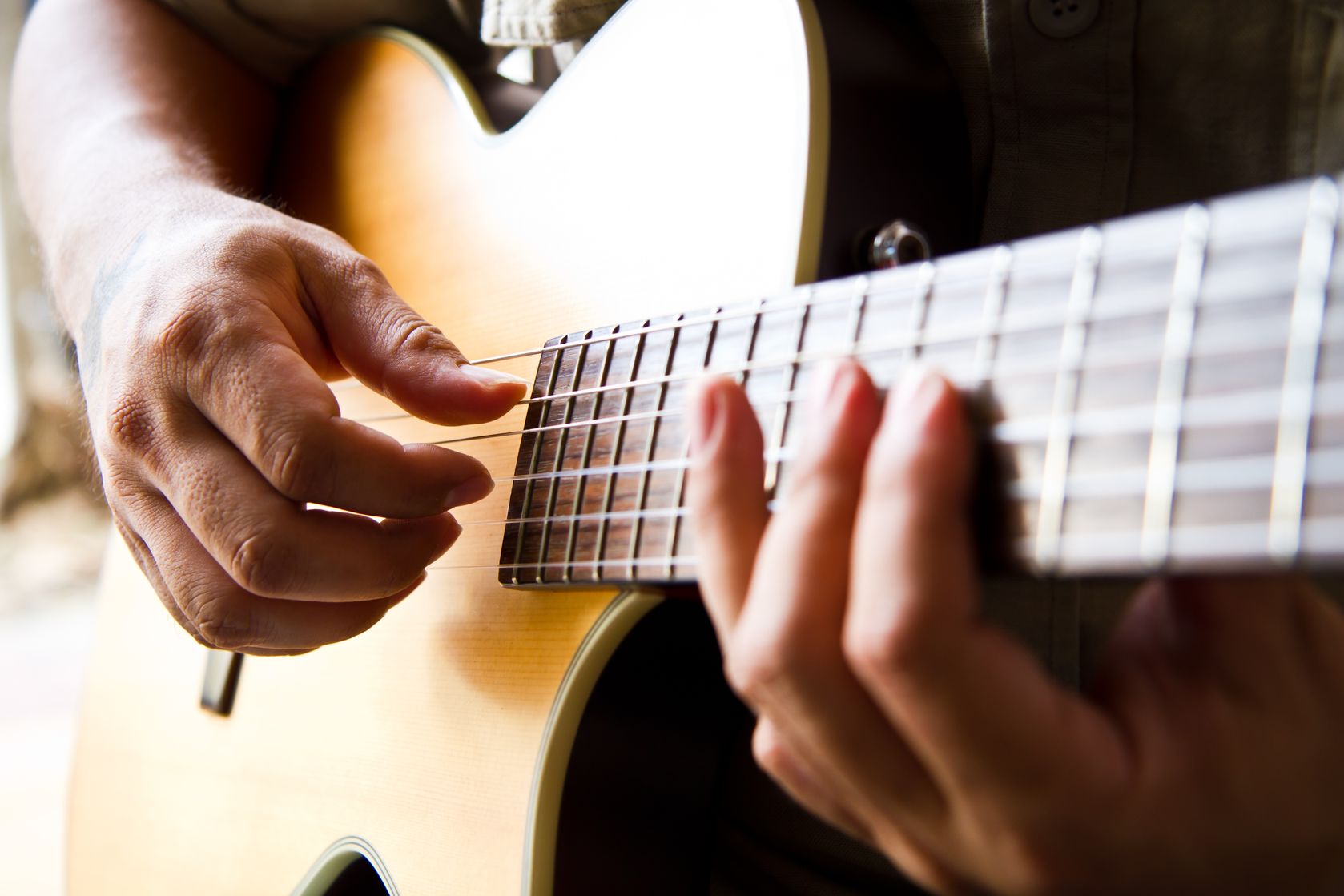







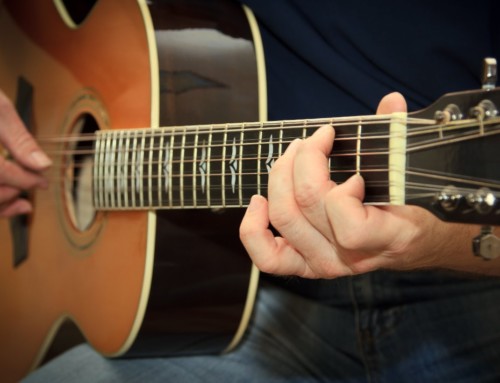

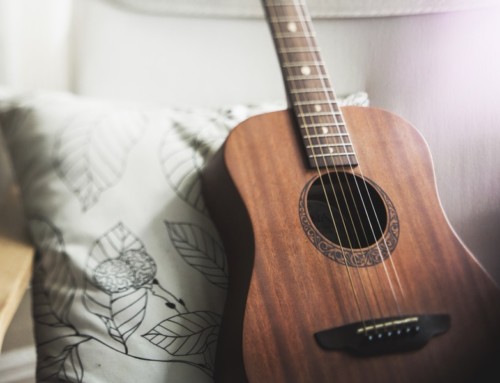

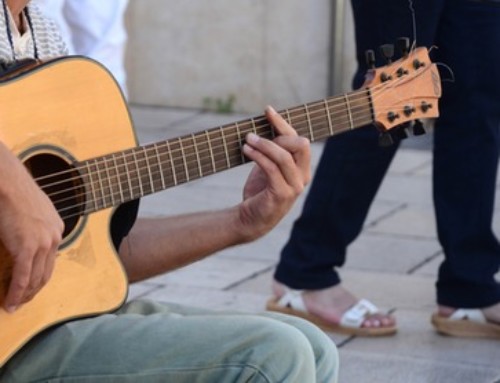
Leave A Comment